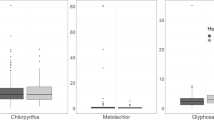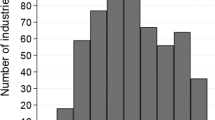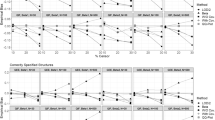Abstract
In retrospective epidemiological studies of large cohorts of workers exposed to radioactive materials, it is often necessary to analyze large numbers of bioassay data sets containing censored values, or values recorded as less than a detection limit. Censored bioassay data create problems for all bioassay analysis methods, including analytical techniques based on least-squares regression to estimate intakes. A method is presented here that uses a simple empirically-derived equation for imputing replacement values for urine uranium concentration results reported as zero or less than a detection limit, that produces minimal bias in intakes estimated using least-square regression methods with the assumption of lognormally distributed measurement errors.
This is a preview of subscription content, access via your institution
Access options
Subscribe to this journal
Receive 6 print issues and online access
$259.00 per year
only $43.17 per issue
Buy this article
- Purchase on Springer Link
- Instant access to full article PDF
Prices may be subject to local taxes which are calculated during checkout




Similar content being viewed by others
References
Anderson JL, Apostoaei AI, Thomas BA . Estimation of internal exposure to uranium with uncertainty from urinalysis data using the InDEP computer code. Radiat Prot Dosimetry 2013; 153: 64–73.
Hornung RW, Reed LD . Estimation of average concentration in the presence of nondetectable values. Appl Occup Environ Hyg 1990; 5: 46–51.
Helsel D . Much ado about next to nothing: incorporating nondetects in science. Ann Occup Hyg 2010; 54: 257–262.
Cohen AC . On the solution of estimating equations for truncated and censored samples from normal populations. Biometrika 1957; 44: 225–236.
Cohen AC . Tables for maximum likelihood estimates: singly truncated and singly censored samples. Technometrics 1961; 3: 535–541.
Shumway RH, Azari RS, Kayhanian M . Statistical approaches to estimating mean water quality concentrations with detection limits. Environ Sci Technol 2002; 36: 3345–3353.
Hewett P, Ganser GH . A comparison of several methods for analyzing censored data. Ann Occup Hyg 2007; 51: 611–632.
Helsel DR . Less than obvious—statistical treatment of data below the detection limit. Environ Sci Technol 1990; 24: 1766–1774.
Gilbert RO, Kinnison RR . Statistical methods for estimating the mean and variance from radionuclide data sets containing negative, unreported or less-than values. Health Phys 1981; 40: 377–390.
Boecker B, Hall R, Lawrence J, Ziemer P, Eisele G, Wachholz B et al. Current status of bioassay procedures to detect and quantify previous exposures to radioactive materials. Health Phys 1991; 60: 45–100.
Yahaya AS, Yee CS, Ramli NA, Ahmad F . Determination of the best probability plotting position for predicting parameters of the Weibull distribution. Int J Appl Sci Technol 2012; 2: 106–111.
Castellani CM, Marsh JW, Hurtgen C, Blanchardon E, Berard P, Giussani A et al. IDEAS Guidelines (Version 2) for the Estimation of Committed Doses from Incorporation Monitoring Data. European Radiation Dosimetry Group e.V. Braunschweig, 2013 Report No. EURADOS-2013-01.
Marsh JW, Birchall A . Estimation of uptake from censored urine excretion data. Radiat Prot Dosimetry 1994; 53: 187–190.
Author information
Authors and Affiliations
Corresponding author
Ethics declarations
Competing interests
The authors declare no conflict of interest.
Additional information
Disclaimer
The findings and conclusions in this report are those of the authors and do not necessarily represent the views of the National Institute for Occupational Safety and Health.
Rights and permissions
About this article
Cite this article
Anderson, J., Apostoaei, A. Method for analyzing left-censored bioassay data in large cohort studies. J Expo Sci Environ Epidemiol 27, 1–6 (2017). https://doi.org/10.1038/jes.2015.36
Received:
Revised:
Accepted:
Published:
Issue Date:
DOI: https://doi.org/10.1038/jes.2015.36
Keywords
This article is cited by
-
Comparison of statistic methods for censored personal exposure to RF-EMF data
Environmental Monitoring and Assessment (2020)



